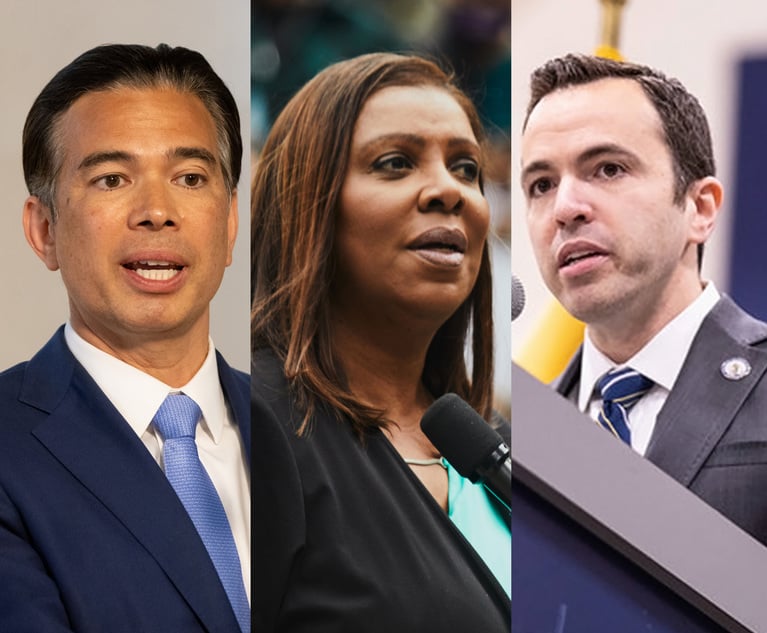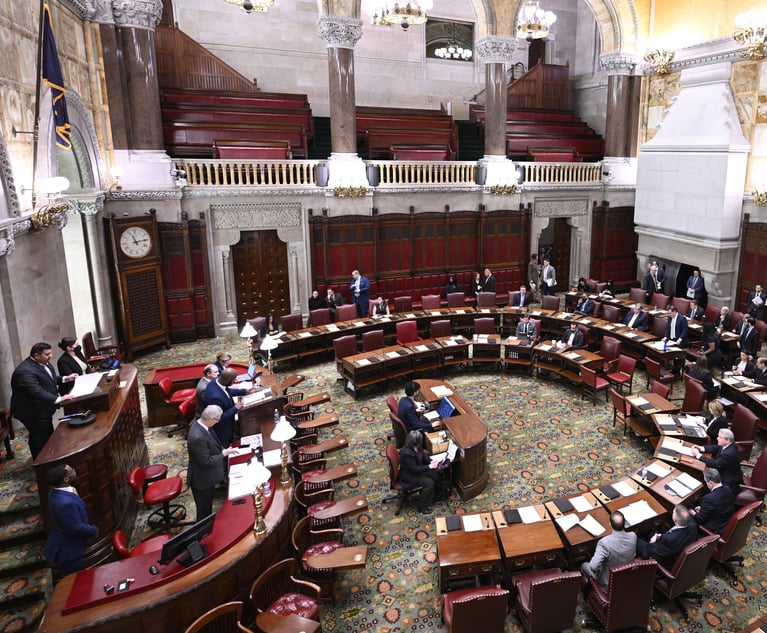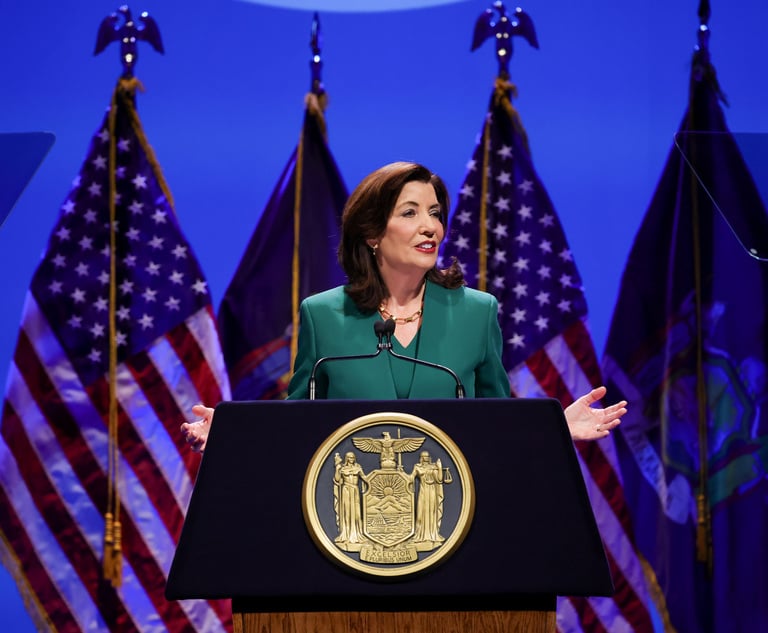NY State Courts Prepared for Flood of Lawsuits Under New Child Victims Act, Officials Say
“The revived Child Victims Act cases are critically important cases, raising numerous challenging legal issues, that must be adjudicated as consistently and expeditiously as possible across the State,” said Chief Administrative Judge Lawrence Marks.
August 13, 2019 at 02:33 PM
8 minute read
 New York Capitol, Albany (Photo: LennonsGhost/iStockphoto.com)
New York Capitol, Albany (Photo: LennonsGhost/iStockphoto.com)
Editor’s note: This article is the second of a two-part series. Read the first part here.
After months of planning and training, officials within the state court system in New York say they’re ready for the thousands of civil cases expected to be filed in the coming weeks related to child sex abuse suffered by victims over the last several decades.
Many of those cases are expected to be filed this week under the Child Victims Act, a new law that created a one-year revival window starting Wednesday for victims to bring civil litigation related to their abuse, regardless of when it happened.
A similar one-year window was enacted in California more than a decade ago, during which approximately 1,000 cases were filed related to child sex abuse. Law firms in New York are likely to exceed that number. Three firms, alone, identified by the New York Law Journal are ready to file more than 1,000 lawsuits collectively.
Those cases are planned to be filed in the coming days, and attorneys have said they expect more victims to approach them with claims throughout the one-year window. Victims don’t have to resolve their litigation by that time, they only have to file it.
That doesn’t mean those cases are expected to drag on for years, which isn’t uncommon for civil litigation. The state Office of Court Administration created a new set of rules in recent weeks to address, specifically, how the state’s courts will handle cases brought under the Child Victims Act during the one-year window.
The last thing state court officials want to see is a backlog of those cases, which could, in turn, lead to delays in unrelated litigation.
To avoid that, they’ve designated special parts in New York City and each judicial district where cases brought during the one-year window will be assigned. Statewide, 45 judges have been designated to hear those cases, with 12 in New York City alone.
Those judges and others have undergone training on the new law and issues that could arise while presiding over civil litigation related to child sex abuse, according to OCA.
When a case is filed, it will remain on the county docket, but be assigned to one of five regionally-designated judges for all pretrial proceedings, including conferences and motions.
In New York City, all cases will be assigned for pretrial proceedings to Justice George Silver, the deputy chief administrative judge for courts within the five boroughs.
Four judges have been chosen outside New York City to preside over pretrial proceedings:
- Justice Michael Mackey will handle cases in the Third and Fourth Judicial Districts in the eastern part of the state.
- Justice Michael Coccoma will handle cases in the Fifth and Sixth Judicial Districts in Central New York.
- Justice Deborah Chimes will handle cases in the Seventh and Eighth Judicial Districts in Western New York.
- Justice Terry Jane Ruderman will handle cases in the Ninth and Tenth Judicial Districts in the New York City suburbs and on Long Island.
To those judges, and other court officials involved in the litigation, OCA issued a reminder alongside the new rules.
“Judges and other court personnel involved in actions revived pursuant to [The Child Victims Act], in the exercise of their discretion in any matter relating to such action, shall be mindful of the statutory directive that such actions be adjudicated in a timely fashion,” the rules read.
To really drive that point home, state court officials have even provided a recommended timeline for judges to “aspire to” in each case. A preliminary conference is recommended to be set within 30 days of the lawsuit’s filing. Discovery is recommended to be finished within a year of that conference.
Judges handling those cases are then recommended to accept dispositive motions, like to throw out or resolve the lawsuit, within 90 days after the close of discovery. Those motions are recommended to be decided within a month after attorneys have filed their briefs on the matter.
If you follow civil litigation in state courts, you’ll know that such an expedited timetable is not the norm. Judges can take months to decide on dispositive motions, alone, which can often delay a case for years before a resolution. The goal, here, is to avoid that and ensure these cases are resolved quickly, and with fewer hurdles.
“The revived Child Victims Act cases are critically important cases, raising numerous challenging legal issues, that must be adjudicated as consistently and expeditiously as possible across the State,” said Chief Administrative Judge Lawrence Marks. “We are fully committed to providing appropriate and sufficient resources to achieve that goal.”
If a case makes it to trial, state court officials recommend that judges schedule the proceeding for shortly after the end of discovery, or after a decision on any dispositive motion, assuming that doesn’t end in the case being resolved.
Attorneys who’ve prepared cases to be filed during the one-year window have said they expect the institutions they’ve targeted, like churches and schools, to settle most cases, rather than pursue them to trial. That’s been the common result in other states that have enacted similar measures, they’ve said.
State court officials have planned for that, as well, by requiring each case to be assigned to one of the state’s 45 designated judges for a parallel alternative dispute resolution track, or ADR, with a goal of settlement. If the case doesn’t settle, it will go to trial before that judge.
Karen Bitar, a partner at Seyfarth Shaw, has represented institutions in cases of alleged employee misconduct, including when Yeshiva University was targeted with claims of sexual abuse and Title IX violations in 2014.
She predicted that cases brought during the one-year window will have a tough time sticking to the state’s recommended deadlines.
“It will be interesting to see how this plays out, and the extent to which ADR is utilized, where most practitioners familiar with New York state court practice think that the timetable, as set, will be hard to meet,” Bitar said. “Even [OCA] recognizes this concern, as it defines its own timetable as something to ‘aspire’ to.”
The court system is also planning to develop and adopt a case management order to provide consistency for the thousands of cases expected to be filed during the one-year window. That’s similar to what the state has done to manage several cases alleging asbestos-related damages.
There’s also the possibility that state lawmakers will extend the one-year window to accommodate victims who don’t have the chance, or don’t feel ready, to pursue litigation over the next year. That was discussed earlier this year by lawmakers, who decided to take a wait-and-see approach at the time.
State Sen. Brad Hoylman, D-Manhattan, sponsored the Child Victims Act when it passed the state Legislature this year. He said in an interview with the New York Law Journal that he wants to see how many cases are filed between now and the start of next year’s legislative session in January before proposing to extend the window.
“I would like to see how many cases are filed between now and the session,” Hoylman said. “If we’re seeing many cases over the next few months, I think it’s something the Legislature needs to consider, because it suggests that we need more time.”
There’s no solid estimate on just how many cases will be filed over the next year. Hoylman was surprised to hear that one law firm interviewed by the Law Journal expected to file 550 cases—about half of the cases seen in California during its lookback window in 2003.
But the state’s court system has said it’s prepared for whatever attorneys decide to throw at it, said Hoylman, who also chairs the Judiciary Committee in the state Senate.
“They’re confident in their ability to handle this number of cases but I don’t think anybody really knows what to expect,” Hoylman said.
READ MORE:
Wave of Abuse Lawsuits Under New Child Victims Act Is Expected to Crest in NY
Rockefeller University Sues Insurers for Coverage of Past Child Sex Abuse Claims
NY Archdiocese Sues Insurers After Coverage Denied for Child Sex Abuse Claims
This content has been archived. It is available through our partners, LexisNexis® and Bloomberg Law.
To view this content, please continue to their sites.
Not a Lexis Subscriber?
Subscribe Now
Not a Bloomberg Law Subscriber?
Subscribe Now
NOT FOR REPRINT
© 2025 ALM Global, LLC, All Rights Reserved. Request academic re-use from www.copyright.com. All other uses, submit a request to [email protected]. For more information visit Asset & Logo Licensing.
You Might Like
View All

Federal Judge Pauses Trump Funding Freeze as Democratic AGs Plan Suit
4 minute read
Relaxing Penalties on Discovery Noncompliance Allows Criminal Cases to Get Decided on Merit
5 minute read
Bipartisan Lawmakers to Hochul Urge Greater Student Loan Forgiveness for Public-Interest Lawyers
Trending Stories
- 1Uber Files RICO Suit Against Plaintiff-Side Firms Alleging Fraudulent Injury Claims
- 2The Law Firm Disrupted: Scrutinizing the Elephant More Than the Mouse
- 3Inherent Diminished Value Damages Unavailable to 3rd-Party Claimants, Court Says
- 4Pa. Defense Firm Sued by Client Over Ex-Eagles Player's $43.5M Med Mal Win
- 5Losses Mount at Morris Manning, but Departing Ex-Chair Stays Bullish About His Old Firm's Future
Who Got The Work
J. Brugh Lower of Gibbons has entered an appearance for industrial equipment supplier Devco Corporation in a pending trademark infringement lawsuit. The suit, accusing the defendant of selling knock-off Graco products, was filed Dec. 18 in New Jersey District Court by Rivkin Radler on behalf of Graco Inc. and Graco Minnesota. The case, assigned to U.S. District Judge Zahid N. Quraishi, is 3:24-cv-11294, Graco Inc. et al v. Devco Corporation.
Who Got The Work
Rebecca Maller-Stein and Kent A. Yalowitz of Arnold & Porter Kaye Scholer have entered their appearances for Hanaco Venture Capital and its executives, Lior Prosor and David Frankel, in a pending securities lawsuit. The action, filed on Dec. 24 in New York Southern District Court by Zell, Aron & Co. on behalf of Goldeneye Advisors, accuses the defendants of negligently and fraudulently managing the plaintiff's $1 million investment. The case, assigned to U.S. District Judge Vernon S. Broderick, is 1:24-cv-09918, Goldeneye Advisors, LLC v. Hanaco Venture Capital, Ltd. et al.
Who Got The Work
Attorneys from A&O Shearman has stepped in as defense counsel for Toronto-Dominion Bank and other defendants in a pending securities class action. The suit, filed Dec. 11 in New York Southern District Court by Bleichmar Fonti & Auld, accuses the defendants of concealing the bank's 'pervasive' deficiencies in regards to its compliance with the Bank Secrecy Act and the quality of its anti-money laundering controls. The case, assigned to U.S. District Judge Arun Subramanian, is 1:24-cv-09445, Gonzalez v. The Toronto-Dominion Bank et al.
Who Got The Work
Crown Castle International, a Pennsylvania company providing shared communications infrastructure, has turned to Luke D. Wolf of Gordon Rees Scully Mansukhani to fend off a pending breach-of-contract lawsuit. The court action, filed Nov. 25 in Michigan Eastern District Court by Hooper Hathaway PC on behalf of The Town Residences LLC, accuses Crown Castle of failing to transfer approximately $30,000 in utility payments from T-Mobile in breach of a roof-top lease and assignment agreement. The case, assigned to U.S. District Judge Susan K. Declercq, is 2:24-cv-13131, The Town Residences LLC v. T-Mobile US, Inc. et al.
Who Got The Work
Wilfred P. Coronato and Daniel M. Schwartz of McCarter & English have stepped in as defense counsel to Electrolux Home Products Inc. in a pending product liability lawsuit. The court action, filed Nov. 26 in New York Eastern District Court by Poulos Lopiccolo PC and Nagel Rice LLP on behalf of David Stern, alleges that the defendant's refrigerators’ drawers and shelving repeatedly break and fall apart within months after purchase. The case, assigned to U.S. District Judge Joan M. Azrack, is 2:24-cv-08204, Stern v. Electrolux Home Products, Inc.
Featured Firms
Law Offices of Gary Martin Hays & Associates, P.C.
(470) 294-1674
Law Offices of Mark E. Salomone
(857) 444-6468
Smith & Hassler
(713) 739-1250






